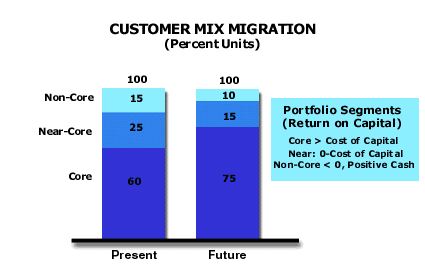BASIC STRATEGY GUIDE: STEP 26
Activity Four:
Manage the Company’s cost structure to create Economies of Scale while offering good value to Core customers.
Step 26: Identify the profit increase from the improvement in the mix of customers that the Company serves.

What:
Calculate the profit increase from the Company’s improvement in the proportion of sales to Core customers by the end of the planning horizon. This step builds on the work from Basic Strategy Guide Step 11.
Why:
The Company may improve its cost and margin position by changing the mix of its relationships with customers to increase its sales to profitable Core customers, and to reduce its resources used with Near-core and Non-core customers. This improvement in mix of customers will certainly improve the Company’s operating margins or return on sales. It may also improve the Company’s use of its Net Capital Employed.
Elimination of Unattractive Customers Examples>>
What to Watch For:
-
In a Stable market, the relative size of the customer is a good indicator of the customer’s likely profitability. The larger customers tend to be more profitable than smaller customers. In a Hostile market, the price the customer pays is more important than the customer’s size in estimating customer profitability. In fact, profitability may be inversely related to size. The smaller customers may be more profitable than the larger customers.
-
In some cases, the Company would choose to serve an industry-leading customer due to the Industry Leader Effect. With this condition, an otherwise unprofitable industry-leading customer becomes attractive to the Company because serving that customer brings with the service a substantial volume of profitable smaller customers.
-
The ideal is for the Company to use all of its capacity for Core customers. This ideal is difficult to achieve because customer needs and demands can be somewhat unpredictable. Customer volume may grow at a different rate than the Company can add economic capacity. A modified ideal is to use Near-Core customer sales volume to provide for Core customer growth and unforeseen needs.
-
The Company would not invest capital, nor incur expenses with longer term pay outs, such as research and development projects, to support Non-Core or even Near-Core customers. These customers do not generate enough return to pay for the Company’s investment.
-
Audio Tip #57: Adding Capacity for Near and Non-core Customers
-
As the Company runs out of available capacity, it would draw down its sales to Non-Core and then Near-Core customers in order to support the Core customers, until it has reached the point where all its capacity is employed for the Core customers. By that point, it should be able to add any form of new capacity on an economically attractive basis.
-
In a Hostile marketplace, the Company would sell to any customer as long as the sale would result in positive net cash flow for the Company. However, in assessing the positives and negatives of the sale, the Company must consider whether a particularly low price to a Non-Core customer might spread to other more important customers in the market or harm one of the Company’s more valuable Core customers.
Action:
In a Hostile market with overcapacity, first determine whether the Company can use its excess capacity to help improve its position with its Core customers. Once the Company has exhausted this opportunity, pursue and accept relationships with Near-core and Non-core customers. This latter decision produces cash by using its excess capacity. On the other hand, in a Stable or Reprieve industry, withdraw resources from Non-core customers as demand grows to improve the Company’s overall returns. These actions will improve the operating margins and Return on Investment of the Company.
-
Self Test #26: Identify the Profit Increase from the Improvement in the Mix of Customers
-
Worksheet #26: Identify the Profit Increase from the Improvement in the Mix of Customers
More Information on Improving Customer Mix on the Advanced Site>>
For helpful context on this step:
Videos:
-
Video #54: Cost Reduction by Winners vs. Losers in Hostility
-
Video #63: Core Customers Part 1: Defining Core, Near and Non-Core Customers
-
Video #64: Core Customers Part 2: Finding Core Customers in Your Marketplace
Perspectives:
Symptoms and Implications:
